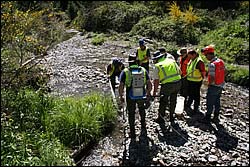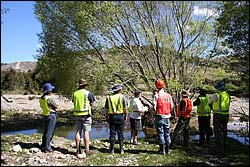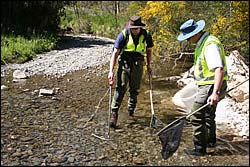Sediment learning group
Research Status: Ongoing |
Sediment learning group electric fishing |
Introduction
A number of innovative ways to facilitate constructive interaction that more closely links science management and policy are being trialed through the programme. One of the latest of these has been the establishment of a Sediment Collaborative Learning (CL) Group.
Research Approach
The Sediment Learning group aimed to provide a new forum to put into practice many of the things that had been talked about. These include a focus on active and experimental learning which emerges from the use of dialogue approaches to develop a shared understanding and adaptive management or “learning by doing” approaches on the ground. The group emerged from a programme initiative in November 2004 that wanted to see how such an approach could develop from discussion among a range of stakeholder interests.
What made this group different was that it was set up among a group of people who wished to find something to work together on, rather than to solve a given problem. Groups that are task-focussed are commonly found in organisations, and can emerge across groups in response to crises. However groups that are focussed on building relationships - i.e. acknowledging that above all they want to work together for their community or environment - have to look for things that they can do together. In science programmes we are normally task focussed, whereas long term environmental management requires an equal emphasis on relationship support. The group did agree to begin with a focus on some issue that relates to sediment management.
Research Results
The group met first in May 05, and comprised Andrew Fenemor, Les Basher, Tim Davie, Roger Young, Will Allen and Margaret Kilvington from the science team. The range of people with different interests that also joined the group comprised Neil Deans, Mick Park, Hayden Henry, Colin Michie, Eric Verstappen, Mary-Anne Baker, Andy Karalus, and Lewis Metcalfe. Lewis and Hayden left the group following job changes.
The group has met in total four times, with their third meeting in October last year being a field trip. The first two meetings involved the group discussing their goals from the
learning group, and working through the range of issues that arise from considering sediment from different viewpoints.
The lessons learnt from the Sediment Collaborative Learning Group feedback into work being done and planned in the ICM programme itself. The lessons being learnt about what works for this group and what doesn’t are being directly linked into other programmes both within New Zealand (e.g the Auckland-based Low Impact Urban Design and Development FRST-funded programme) and internationally (e.g. the Challenge Programme for Water, Food and Environment CGIAR-funded programme).
 |
 |
Sediment learning group field trip |
Sediment learning group field trip |
Recent Publications
Recent Presentations
| Year | Title | File Size |
| 2007 | Sediment dynamics and biological impacts in the Motueka River, New Zealand. |
|
| 2005 | Populating management curves. |
|
BMPs, BEPs and Guidelines
| Title | Description |
| Soil Conservation Technical Handbook | The Soil Conservation Technical Handbook is a comprehensive collection of know how about soil conser...More » |
| New Zealand Environmental Code of Practice for Plantation Forestry | The E CoP is an essential tool for anyone involved in forest management. Developed by the NZFOA, and...More » |
| Design guidelines for earthworks, tracking and crossings. A practitioner´s technical guide to minor effects based activities. | Design guidelines for earthworks, tracking and crossings. A practitioner´s technical guide to...More » |
| Contaminated Land Management Guidelines No. 1: Reporting on Contaminated Sites in New Zealand |
This is the first of a series of documents on contaminated land management, published by the Ministr...More » |
| Risk Screening System Contaminated Land Management: Guidelines No. 3 |
This guideline describes the background to and use of the Risk Screening System (RSS). The sys...More » |
| Contaminated Land Management Guidelines No. 2: Hierarchy and Application in New Zealand of Environmental Guideline Values |
From Executive Summary: This guideline document is the second in a series of documents on cont...More » |
| Earthworks – Erosion and Sediment Control Guidelines | Environment Waikato...More » |
Primary Contacts:

|
Will Allen
Email Phone: 03 321 9600 More details» |
Institute Landcare Research |
Expertise participation, multi–stakeholder processes, participatory evaluation, networking |